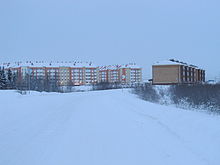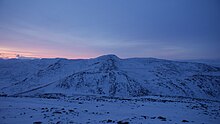极夜
| 天气条目系列之一 |
| 天气 |
|---|
 |
|
|



极夜(英语:Polar night),又称永夜、夜昼、月昼,指地球的两极地区,一日之内,太阳都在地平线以下的现象。极夜仅在极圈内发生[1]。若一日之内太阳都在地平线之上,则被称为极昼,同样也只发生在两极地区。
此处“夜晚”指太阳中心在地平线以下的时间段。但由于大气折射阳光,极昼比极夜长,范围略大于极夜。若北极圈处于极夜,则南极圈处于极昼,反之亦然。具有较大转轴倾角,自转周期远小于轨道周期,不处于潮汐锁定状态的行星或卫星也拥有极夜,即夜晚时长大于自转周期。
规律
[编辑]极地冬至日时,大部分地区仍然有曙暮光,因此天空并不是完全黑暗。只有在极点附近5.5度以内,天空才是完全黑的。在正午时分,靠近极圈的地区会出现极地曙光。
对于极地地区,极夜的长度并不相等。极圈上的极夜只有一天长,而极点处则有179天。由于大气折射,在两极,太阳高于地平线的时长均为186天。
类型
[编辑]

极地曙暮光
[编辑]极地曙暮光出现在极圈以内附近的区域(67.5°-72.5°之间),冬至正午时太阳会完全在地平线以下。此时太阳高度角大于-6°,虽然中天中没有真正的日光,但是有民用曙暮光。虽然户外光照强度不如室内,街灯也会一直亮着,但大多数活动仍可进行。此时光照不强,治疗季节性抑郁症患者往往需要用到人造光。
北半球:
- 北纬68°:12月9日至次年1月2日
- 北纬69°:12月1日至次年1月10日
- 北纬70°:11月26日至次年1月16日
- 北纬71°:11月21日至次年1月21日
- 北纬72°:11月16日至次年1月25日
南半球:
- 南纬68°:6月7日至7月3日
- 南纬69°:5月30日至7月11日
- 南纬70°:5月24日至7月18日
- 南纬71°:5月19日至7月23日
- 南纬72°:5月14日至7月27日
民用极夜
[编辑]民用极夜指正午时太阳高度角小于-6°,正午时中天只出现微弱的曙暮光。民用极夜出现在南北纬72.5-78.5°的地方。若是被浓云覆盖,正午天空会变得更暗。在挪威斯瓦尔巴,极夜从11月11日持续到次年1月30日。俄罗斯迪克森的极夜从12月6日开始,持续至次年1月6日。
航海极夜
[编辑]在航海极夜中,天空除正午有一丝曙暮光外,没有一丝日光。正午时,太阳高度角在小于-12°。航海极夜出现在纬度78.5°-84.5°间的地区。加拿大的阿勒特处于该区域,极夜从11月19日开始,持续到次年1月22日[2]。格陵兰北部的乌达克的极夜从11月15日开始,次年1月27日结束[3]。俄罗斯法兰士约瑟夫地群岛的极夜从11月27日开始,1月15日结束。
天文极夜
[编辑]天文极夜正午时太阳高度角小于-18°,正午时几乎没有曙暮光。天文极夜出现在南北纬84.5°及以上的地区。纬度高于84.5°的人类永久定居点只有位于南极点的阿蒙森-史考特南极站。此处每年天文极夜时长约为11周。在南极点,极夜从5月11日开始,持续至8月1日[4]。在北极点,极夜从11月13日开始,持续至次年1月29日[5][6]。
极地太阳的运动周期
[编辑]极点的太阳高度角变化周期为一年。因此,位于极点的观察者在一年内只能看到一次日出和日落[7]。
参考
[编辑]- ^ Burn, Chris. The Polar Night (PDF). The Aurora Research Institute. [2015-09-28]. (原始内容 (PDF)存档于2015-09-30).
- ^ Time and Date.com - Alert, Nunavut, Canada. Time and Date.com. [2019-05-14]. (原始内容存档于2022-05-03).
- ^ Time and Date.com - Oodap Qeqertaa, Greenland. Time and Date.com. [2019-05-16]. (原始内容存档于2022-05-08).
- ^ Time and Date.com - South Pole, Antarctica. Time and Date.com. [2019-06-01]. (原始内容存档于2022-05-03).
- ^ Rao, Joe. The Myth of Arctic Daylight and Darkness Exposed. Live Science. 2010-09-21 [2017-04-14]. (原始内容存档于2022-05-18).
- ^ Time and Date.com - North Pole. Time and Date.com. [2019-05-31]. (原始内容存档于2022-05-08).
- ^ NASA: The Sun and Seasons (页面存档备份,存于互联网档案馆) NASA. (See last paragraph, section 164.) By David Stern. Last updated Sept. 17, 2004. Downloaded Feb. 17, 2017.
另见
[编辑]
|
Text is available under the CC BY-SA 4.0 license; additional terms may apply.
Images, videos and audio are available under their respective licenses.
